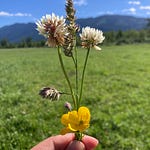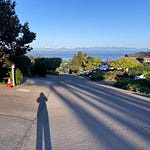There’s a surprising amount of physics involved in bucking a tree.1 It isn’t that I thought there wouldn’t be; rather, I just hadn’t thought about it at all, until I ended up in a small community center on the outskirts of Olympic National Forest, at 9am on a Sunday. I learned about types of crosscut saws and how to safely carry them, sawyering terminology and the various degrees of certification, and appropriate PPE to wear for a logout.2 Much of this was new to me but fairly straightforward. What I didn’t expect, however, was to hear the words “potential energy” so many times - to consider how recently a tree had fallen and the complexity of its landing spot, including leans and binds (fulcrums, bearing points, areas of tension and compression), stacking on or near other logs, and the trapping of any spring poles (small trees bent under a larger one, requiring a rough calculation of the appropriate angle for cutting). I guess if you had asked me before, I would’ve predicted more brute force, a Paul Bunyoning of the situation, arms tiring while I sawed incrementally through a hefty trunk.
It’s quicker work than I thought, bucking. The part that takes the most time is the evaluation and re-evaluation of the scene, imagining how a billet will roll when released from a larger tree, how to protect anyone that may be nearby, how to get it to land in a spot that will not inhibit trail drainage or pose a hazard. The sawing itself is only a small proportion of the overall time, especially considering how flimsy crosscut saws are, another fact I’d had no opportunity to encounter until I stood, wielding one, in the mossy green forest.
Now don’t get me wrong, it’s not easy work, it’s just that crosscut saw blades are so thin, I thought the effort involved might be more akin to using a disposable plastic knife against a watermelon, given the might and density of our PNW trees. Progress came in centimeters, and a good 40 pulls on the saw was enough before rotating with another member of the trail crew. Yet we counted our success in minutes, and I felt the thrill of satisfaction every time we sliced through the last few fibers holding a log together.
To be clear, I am not advocating for slicing down trees willy nilly. The work we were doing was in service of making trails safely traversable, clearing hazards, and promoting proper trail drainage. Though we were just practicing on this day, the work was rewarding. I liked the way it engaged both body and mind, how we approached a scene like a physics problem, how each team member’s observations were needed and valued.
I took the ferry home, warming my hands on a decaf latte, hard hat and other gear jumbled on the seat next to me, glistening from the first drops of afternoon rain.3

Later that evening, I went to a concert, where a young singer-songwriter was performing, one of the openers. She was good, but green, and vibrated with the tremors of nerves and an assuredness that she has not quite fully stepped into. A woman with a neat bob who could only be her mother stood in the front row, recording every song on her iPhone. She waved her hands and cheered. The singer on stage winked at her, hokey and exaggerated, high on the adrenaline of performing.
The set was fun and high energy, but I teared up briefly, far enough away from my friend in the crowd that I figured he wouldn’t see. I thought of how lucky this young woman was, that her mother could be there at her performance, that she would stay up late and record every song, that she would dance along while her daughter sang about being free. I hope they both know how special that is.
I feel so keenly aware of my time these days. Impermanence will do that to you. Knowing that I’m leaving Seattle, every day feels important. Recently, I lost a standing breakfast date with a friend. Both of our schedules changed. I felt the hot knife of grief, quick and sharp, part of a friendship severed like a limb. I feared this was the beginning of the end.
But it’s not. It’s just a change. One that I know I will grow deeply in.
What I like about impermanence, and what makes the grief worth it, is the gratitude that comes with it. What a gift that I get to leave a life here that I love for a new adventure.
I am checking items off my Seattle bucket list, trying new restaurants, an oil pastels class, tea tasting, athletic ventures, meeting local artists, performing at open mics. I’m connecting with new people and soaking up every minute with my closest loved ones.
And then I have the nights, like last night, where I’m so tired from it all that I crawl into bed at 6:30, rubbing my socks together from the comfort of my blanketed cocoon, and I sleep for 11 hours.
Of course, part of the emotional weight is living in such a dystopic time, with suffering and uncertainty present virtually everywhere.
I think about what it means to feel alive, and to me it is being present through all of it - the doubt, fear, joy, curiosity, adventure. I feel alive in this impermanence, and I hope I never lose it, I hope I spend the rest of my life crooning at new buds on my plants and tearing up at concerts and learning how to make safe cuts in fallen trees.
Special Note! In one of my February posts, I announced that for Black History Month, I would donate $1 for every new free subscriber, and $5 for every new paid subscriber to Black-led charitable organizations. 15 new free subscribers joined us in February, so I donated $15 to Byrd Barr Place, a nonprofit offering essential services — food, shelter, warmth and financial tools — for neighbors in Seattle to build stability and self-sufficiency. Even the little things matter. Thank you for being a part of it.
For those unfamiliar, sawing a tree that has already fallen is called bucking. Sawing a tree in an effort to bring it down is called felling. I learned that there are both bucking and felling saws, distinguishable by the curve of their spines (spines is not the technical term, but I think it’s the most apt). Our work this day was focused on bucking.
A trail work party where hazardous felled trees are safely cut and/or relocated
For anyone in the PNW interested in logout work, checkout work parties through WTA, Pacific Crest Trail Association, Back Country Horsemen of Washington, Evergreen Mountain Bike Alliance, and Trailkeepers of Oregon.












Share this post